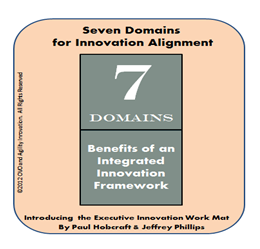 The Executive Innovation Work Mat methodology requires investigation and engagement across the seven domains or components that make up the work mat. The aim of any work mat discussions undertaken with executives focuses upon bringing out the parts necessary for innovation to happen and that needs an integrated approach and lasting engagement from senior management.
The Executive Innovation Work Mat methodology requires investigation and engagement across the seven domains or components that make up the work mat. The aim of any work mat discussions undertaken with executives focuses upon bringing out the parts necessary for innovation to happen and that needs an integrated approach and lasting engagement from senior management.
In a series of articles I will be looking at each of the seven components within the work mat to raise questions to probe and prompt the necessary thinking that needs to be made in organizations determined to build a lasting innovation competence and structure.
I’ve already offered some opening thoughts on Governance and Innovation, for me one of the basic building blocks for innovation lies in creating the right conditions for an Environment to innovate.
So what are those environmental conditions required for innovation?
Continue reading “The environment for innovation does really matter”
